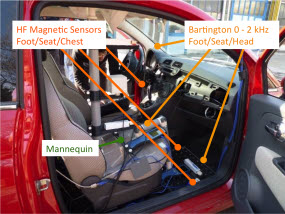|
Measurement of the magnetic field inside electric vehicles
Eight different electric vehicles (including full electric vehicles, hybrid, plug-in hybrid and fuel cell vehicles), two conventional gasoline and one diesel car have been used to study the level of the magnetic field inside these cars.
A measurement set-up made-up of a "mannequin" with sensors in the area of the head, chest and feet has been used to achieve standardized and comparable measurement results. The measurements have been done both in the laboratory and while driving on the road. The laboratory tests were also used to identify the different sources of the magnetic field inside the car. The results were analyzed using the weighted field values with a filter function that reflects the frequency dependency of the reference levels for multi-frequency exposure as recommended by ICNIRP in Guidelines for limiting exposure to time-varying electric and magnetic fields (1 Hz to 100 kHz). The evaluation of these results showed that in the area of the feet the maximum exposure is 20% of the ICNIRP level for electric vehicles (at start-up) compared to about 10% for the measured combustion engine cars. In the area of the head, the values were down to 2% of the ICNIRP levels.
Measurement set-up with mannequin and sensors |
| |



